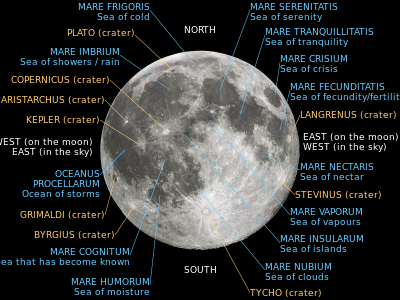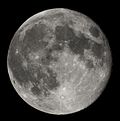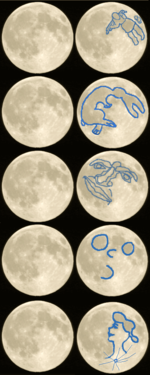- Man in the Moon
-
For other uses, see Man in the Moon (disambiguation).
 Lunar nearside with major maria and craters labeled
Lunar nearside with major maria and craters labeled
The Man in the Moon is an imaginary figure resembling a human face, head or body, that observers from some cultural backgrounds typically perceive in the bright disc of the full moon. The figure is composed of the dark areas (the lunar maria, or "seas") and lighter highlands of the lunar surface.
In one common Western perception of the face, the figure's eyes are Mare Imbrium and Mare Serenitatis, its nose is Sinus Aestuum, and its open mouth is Mare Nubium and Mare Cognitum. An older European tradition sees a figure of a man (Maria Serenitatis, Tranquilitatis, Fecunditatis and Nectaris) carrying a wide burden (Mare Vaporum and Lacus Somniorum) on his back. He is sometimes seen as accompanied by a small dog (Mare Crisium). Conventionalized illustrations of the Man in the Moon often seen in Western art show a very simple face in the full moon, or a human profile in the crescent moon, corresponding to no actual markings.
"The Man in the Moon" can also refer to a mythological character said to live on or in the moon, but who is not necessarily represented by the markings on the face of the moon. An example is Yue-Laou, from Chinese tradition.
Contents
Origin stories
There are various explanations as to how there came to be a Man in the Moon.
A longstanding European tradition holds that the man was banished to the moon for some crime. Christian lore commonly held that he is the man caught gathering sticks on the sabbath and sentenced by God to death by stoning in the book of Numbers XV.32-36[1][1]. Some Germanic cultures thought he was a man caught stealing from a neighbor's hedgerow to repair his own. There is a Roman legend that he is a sheep-thief.
One medieval Christian tradition claims him as Cain, the Wanderer, forever doomed to circle the Earth. Dante's Inferno[2] alludes to this:
- "For now doth Cain with fork of thorns confine
- On either hemisphere, touching the wave
- Beneath the towers of Seville. Yesternight
- The moon was round."
This is mentioned again in his Paradise[3]:
- But tell, I pray thee, whence the gloomy spots
- Upon this body, which below on earth
- Give rise to talk of Cain in fabling quaint?”
There is also a Talmudic tradition that the image of Jacob is engraved on the moon,[4] although no such mention appears in the Torah[5][2].
John Lyly says in the prologue to his Endymion (1591), "There liveth none under the sunne, that knows what to make of the man in the moone."
In Norse mythology, Máni is the male personification of the moon who crosses the sky in a horse and carriage. He is continually pursued by the Great Wolf Hati who catches him at Ragnarok. The name Máni simply means "Moon".
In Haida mythology, the figure represents a boy gathering wood, who was taken up from the earth as a punishment for disrespect.[6]
Traditions
- There is a tradition that the Man in the Moon enjoyed drinking, especially claret. An old ballad runs (original spelling):[7]
- "Our man in the moon drinks clarret,
- With powder-beef, turnep, and carret.
- If he doth so, why should not you
- Drink until the sky looks blew?"
Plutarch, in his treatise, Of the Face appearing in the roundle of the Moone, cites the poet Agesinax as saying of that orb,[8]
- "All roundabout environed
- With fire she is illumined:
- And in the middes there doth appeere,
- Like to some boy, a visage cleere;
- Whose eies to us doe seem in view,
- Of colour grayish more than blew:
- The browes and forehead tender seeme,
- The cheeks all reddish one would deeme."
In the renaissance, the man in the moon was known as Moonshine and carries a lantern as a traditional accessory.
- Ay, or else one must come in with a bush of thorns and
- A lantern, and say he comes to disfigure, or to present,
- The person of Moonshine.
A Midsummer Night's Dream (3.1.51-53)
There is a traditional Mother Goose nursery rhyme featuring the Man in the Moon:
- "The man in the moon came down too soon,
- and asked his way to Norwich,
- He went by the south and burnt his mouth
- By supping on cold plum porridge."
The Traditional English verse reads
- "The man in the moon came down too soon,
- and asked his way to Norwich,
- They sent him south and he burnt his mouth
- By eating cold pease-porridge."
Pareidolia and other things on the moon
The Man in the Moon is an example of pareidolia. Other cultures perceive the silhouette of a woman, a hare/rabbit, a frog, a moose, a buffalo, or a dragon (with its head and mouth to the right and body and wings to the left) in the full moon. Alternatively, the vague shape of the overall dark and light regions resemble a Yin Yang symbol.
Woman
In Elizabethan England, the spots of the Moon were supposed to represent a witch carrying sticks of wood on her back, or an old man with a lantern (which was illustrated by Shakespeare in his comedy A Midsummer Night's Dream). A more recent Western image is the profile of a coiffed woman wearing a jeweled pendant, the jewel being the crater Tycho, which at full moon is very bright and has bright radiating lines (rays). In New Zealand Māori legend, the moon shows a woman with a local tree, the Ngaio. However, throughout Melanesia and Polynesia, the moon is seen to be a cook over a three-stone fire.
Many lunar deities are also female, e.g. Hecate, Selene and Artemis, whose Roman name is Diana, in Greek Mythology. See Category:Lunar goddesses.
In Chinese Mythology, Chang'e (various spellings) lives on the moon. She was mentioned in the conversation between Houston Capcom and Apollo 11 crew just before the first moon landing:[9]
Houston: Among the large headlines concerning Apollo this morning there's one asking that you watch for a lovely girl with a big rabbit. An ancient legend says a beautiful Chinese girl called Chang-o has been living there for 4000 years. It seems she was banished to the moon because she stole the pill for immortality from her husband. You might also look for her companion, a large Chinese rabbit, who is easy to spot since he is only standing on his hind feet in the shade of a cinnamon tree. The name of the rabbit is not recorded.
Collins: Okay, we'll keep a close eye for the bunny girl.—NASA Capcom and Apollo 11 crew, NASA[10]Toad and toadstool
"The toad was seen by Chinese Taoists as ... the moon, representing Chang-O, the transformed wife of Yi, the excellent archer. ... According to Robert M. DeGraaff, in some representations of the moon-toad, the ling chih fungus is shown growing out of the creature's forehead."[11]
Rabbit/hare
Main article: Moon rabbitIn Chinese culture, the rabbit in the moon (a companion of Chang'e) is pounding medicine. Similarly, in Japan and Korea, popular culture sees a rabbit making mochi and tteok, respectively, in the moon. The mythology of Pre-Columbian Mesoamerica also featured a lunar rabbit, for example, Tecciztecatl, the Aztec moon god, was sometimes pictured as an anthropomorphic rabbit.
Hazrat Ali's name on the moon
Shia Muslims believe that the name of Hazrat Ali Ibne-Abi Talib (Muhammad's son in law) is written on the moon. This interpretation has roots in several hadith by Muhammad where he compares Ali to the Moon and himself to the Sun. There are also other esoteric interpretations of this analogy in Islamic philosophy.
References
- ^ Harley, the Rev. Timothy, FRAS (1885). Moon Lore, London; Swan Sonnenschein, Le Bas & Lowry. p.21
- ^ Dante, The Divine Comedy, Inferno, canto 20, line 126 and 127. The Dante Dartmouth Project contains the original text and centuries of commentary.
- ^ Dante, The Divine Comedy, Paradiso, canto 2, line 51.
- ^ Wolfson, Elliot R. "The Face of Jacob in the Moon" in The Seductiveness of Jewish Myth: Challenge or Response? edited by S. Daniel Breslauer, Albany NY; SUNY Press, 1997
- ^ Harley, the Rev. Timothy, FRAS (1885). Moon Lore, London; Swan Sonnenschein, Le Bas & Lowry. P.21
- ^ The Hydah mission, Queen Charlotte's Islands Charles Harrison, Church Missionary Society c. 1884
- ^ The Man in the Moon drinks Claret, as it was sung at the Court in Holy-well. Bagford Ballads, Folio Collection in the British Museum, vol. ii. No. 119.
- ^ Plutarch's Morals. Translated by Holland. London, 1603, p. 1160.
- ^ Onion-Club, Chang-e, About the Moon Festival
- ^ Apollo 11 Technical Air-to-Ground Voice Transcription
- ^ Adrian Morgan : Toads and Toadstools. Celestial Arts, 1995. ISBN 0-89087-777-7. p. 157
External links
- Man in the Moon lore
- Toad, Frog, and Rabbit in the Moon lore
- The Crab in the Moon
- Moon Illusions
- The Man in the Moon and other weird things
Mythology
- Rabbit in the Moon Contrasting Asian and Aztec legends about the Moon Rabbit (See also Mochi (food))
Chinese moon festival legends
- Chang Er flies to the Moon Another version of the Chang_Er story
- The Legend of Wukang A sort of Chinese Tantalus
- The Man in the Moon
The Moon Physical features 
Orbit Lunar surface - Selenography
- Near side
- Far side
- Lunar mare
- (List)
- Craters
- (List)
- Mountains
- Valleys
- South Pole – Aitken basin
- Shackleton crater
- Water
- Soil
- Peak of eternal light
- Space weathering
- Transient lunar phenomenon
Lunar science Exploration Other topics - See also Solar System
- Natural satellite
Categories:- Mythological characters
- Moon myths
- Moon in fiction
Wikimedia Foundation. 2010.


